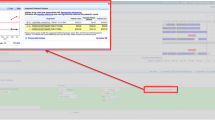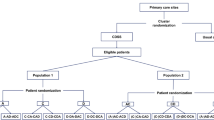Abstract
Background
Success in treating hypertension is greater in clinical trials than in actual practice. To prospectively study real-world antihypertension treatment patterns, therefore, naturalistic studies are essential.
Objective
The primary objective of the Caring for Hypertension on Initiation: Costs and Effectiveness (CHOICE) study was to evaluate the feasibility of performing a naturalistic study in patients with newly diagnosed hypertension in terms of enrollment, adequacy, and the timeliness of data collection and study procedures.
Methods
The CHOICE study prospectively collected actual practice data from physicians, who were blind to the study purpose and hypotheses, treating newly diagnosed hypertensive patients. The initial therapy was randomly assigned to either Group 1 (diuretics or β-adrenoceptor antagonists) or Group 2 (calcium channel antagonists or ACE inhibitors). The protocol made no demands on usual medical care in scheduling visits and changing treatment during follow-up. Only a final visit at 5 ± 1 months was mandated. Direct involvement of the CHOICE study team was minimized using a remote study monitoring system to collect data and communicate with study sites.
Results
Within 30 weeks, a total of 55 physicians enrolled 512 patients with a mean age blood pressure of 158/99mm Hg. In all, 46 different antihypertensive medications were prescribed and 2554 office visits (range 1–16 visits per patient) were attended. Other medical resource use was low during the study period. A final, clean database was ready for analysis 30 days after the last patient visit.
Conclusion
The results of this pilot study demonstrate that CHOICE is a feasible framework within which the real-world effectiveness and cost effectiveness of initial therapy for patients with newly diagnosed hypertension can be studied. Protocol flexibility and a novel electronic data entry system are core elements of this naturalistic design.






Similar content being viewed by others
References
Revicki DA, Frank L. Pharmacoeconomic evaluations in the real world: effectiveness versus efficacy studies. Pharmacoeconomics 1999; 15(5): 423–34
Cabana MD, Rand CS, Powe NR, et al. Why don’t physicians follow clinical practice guidelines? A framework for improvement JAMA 1999; 282: 1458–65
Hershey JC, Morton BG, Davis JB, et al. Patient compliance with antihypertensive medication. Am J Public Health 1980; 70: 1081–9
Luscher TF, Vetter H, Siegenthaler W, et al. Compliance in hypertension: facts and concepts. J Hypertens Suppl 1985; 3: 3–9
Bittar N. Maintaining long-term control of blood pressure: the role of improved compliance. Clin Cardiol 1995; 18: 312–6
Berlowitz DR, Ash AS, Mickey EC, et al. Inadequate management of blood pressure in a hypertensive population. N Engl J Med 1998; 339: 1957–63
Burt VL, Whelton P, Rocella EJ, et al. Prevalence of hypertension in the US adult population: results from the Third National Health and Nutrition Examination Survey, 1988–1991. Hypertension 1995; 25: 305–13
Caro JJ, Salas M, Speckman JL, et al. Persistence with treatment for hypertension in actual practice. CMAJ 1999; 160(1): 31–7
Caro JJ, Salas M, Speckman JL, et al. Effect of initial drug choice on persistence with antihypertensive therapy: the importance of actual practice data. CMAJ 1999; 160(1): 41–6
Monane M, Bohn RL, Gurwitz JH, et al. The effects of initial drug choice and comorbidity on antihypertensive therapy compliance: results from a population-based study in the elderly. Am J Hypertens 1997; 10: 697–704
Bloom BS. Continuation of initial hypertensive medication after 1 year of therapy. Clin Ther 1998; 20: 671–81
Feinstein A. An additional basic science for clinical medicine II: the limitations of randomized trials. Ann Intern Med 1983; 99: 544–50
Andrade SE, Walker AM, Gottlieb LK, et al. Discontinuation of antihyperlipidemic drugs: do rates reported in clinical trials reflect rates in primary care settings? N Engl J Med 1995; 332: 1125–31
Concato J, Shah N, Horowitz RI. Randomized, controlled trials, observational studies, and the hierarchy of research designs. N Engl J Med 2000; 342: 1887–92
Benson K, Hartz AJ. A comparison of observational studies and randomized, controlled trials. N Engl J Med 2000; 342: 1878–86
Radford MJ, Foody JM. How do observational studies expand the evidence base for therapy? JAMA 2001; 286(10): 1228–30
Payne KA, Esmonde-White S. Observational studies of antihypertensive medication use and compliance: is drug choice a factor in treatment adherence? Curr Hypertens Rep 2000; 2(6): 515–24
Birnbaum HG, Cremieux PY, Greenberg PE, et al. Using healthcare claims data for outcomes research and pharmacoeconomic analyses. Pharmacoeconomics 1999; 16(1): 1–7
Liu H, Golin C, Miller L, et al. A comparison study of multiple measures of adherence to HIV protease inhibitors. Ann Intern Med 2001; 134: 968–77
Turner BJ, Hecht FM. Improving on a coin toss to predict patient adherence to medications. Ann Intern Med 2001; 134(10): 1004–6
Lapuerta P, Simon T, Smitten A, et al. Assessment of the association between blood pressure control and health care resource use. Clin Ther 2001; 23(10): 1773–82
Payne KA, Caro JJ. Evaluating the true cost of hypertension management: evidence from actual practice. Expert Rev Pharmacoeconomics Outcomes Res 2004; 4(2): 179–87
Rothman KJ. Modern epidemiology. Boston (MA): Little Brown and Co., 1986: 109–10; 302–3
McAlister FA, Koon KT, Lewanczuk RZ, et al. Contemporary practice patterns in the management of newly diagnosed hypertension. CMAJ 1997; 157(1): 23–30
Paramore LC, Halpern MT, Lapuerta P, et al. Impact of poorly controlled hypertension on healthcare resource utilization and cost. Am J Manag Care 2001; 7: 389–98
Acknowledgements
This study was supported in part by a research grant from Bristol-Myers Squibb, Princeton, NJ, USA. The authors thank Anne V. Tuomari and Noreen Lordan.
Members of The CHOICE Study Group are Joseph Jackson, PhD, Pablo Lapuerta, MD, Mary Osbakken, MD, PhD, and Teresa A. Simon, MPH, Bristol-Myers Squibb, Princeton, NJ, USA; and Jaime Caro, MD, Jean Speckman, MSc, and Krista Payne, MEd, Caro Research Institute, Concord, MA, USA, and Montreal, Quebec, Canada.
The study investigators are Rejinder Bhalla, MD, Nassau Bay, TX, USA; Joseph Dudash, MD, Beavercreek, OH, USA; Larry Gilderman, DO, Pembroke Pines, FL, USA; Michael McCartney, MD, Newburyport, MA, USA; William Mroczek, MD, Falls Church, VA, USA; David Calhoun, MD, Birmingham, AL, USA; Andres Patron, DO, Hollywood, FL, USA; Harvey Resnick, MD, Lake Jackson, TX, USA; Henry Simon, MD, Toms River, NJ, USA; and Gilbert Weisman, DO, Warminster, PA, USA.
Author information
Authors and Affiliations
Corresponding author
Rights and permissions
About this article
Cite this article
Caro, J.J., Hollenberg, N., Jackson, J.D. et al. Caring for Hypertension on Initiation: Costs and Effectiveness (CHOICE). Dis-Manage-Health-Outcomes 12, 327–336 (2004). https://doi.org/10.2165/00115677-200412050-00004
Published:
Issue Date:
DOI: https://doi.org/10.2165/00115677-200412050-00004




